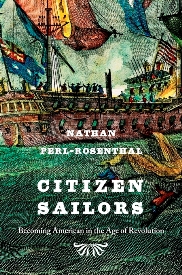 Pirates and Privateers Pirates and Privateers
The History of Maritime
Piracy
Cindy Vallar, Editor
& Reviewer
P.O. Box 425,
Keller, TX 76244-0425
    
Books for
Adults ~ History: Maritime

Citizen Sailors: Becoming
American in the Age of Revolution
by Nathan Perl-Rosenthal
Belknap, 2015, ISBN 978-0-674-28615-3, US $29.95 / UK
£22.95 / EUR Ä27.00
    
Nowadays,
we take nationality for granted. But nationality is
a relatively new concept in the late 18th and early
19th centuries. Before the American Revolution, if
you are born in England or France, then you remain
an English or French subject for your entire life
regardless of where you live. In fact, your
financial status, religion, ethnicity, and family
lineage matter more so than your allegiance to a
particular country does. The upstart colonials upend
this definition when they rebel and become the
United States of America. Perl-Rosenthalís study
focuses on sailors and their role in shaping and
helping to define what it means to be a citizen of
the United States, because seamen are in the
forefront of establishing oneís identity and
citizenship long before most people have to do so.
In the process, he shows how the documents from this
time period eventually evolve into passports and
identity cards we use today.
This question of nationality may seem
straightforward, but at the time, it was not.
Americans and Britons speak English, and there
arenít as significant a difference in our accents as
there is today. Language no longer allows seamen to
differentiate between friend and foe. Complicating
this issue is that some people, like Nathaniel
Fanning, can claim to be either American or French.
Also, since war is frequent during this time period,
ships and sailors of one nation sometimes claim to
be those of another nation. So how can authorities,
such as the British and French governments,
distinguish who truly is an American and who is not?
Perl-Rosenthal answers this question through
historical documents and by looking at some of the
sailors and government officials, such as Edward
Livingston and David Lennox, involved in defining
nationality. Burgess demonstrates that seamen of all
races participate in this, for the prejudices and
restrictions of later decades hasnít yet invaded the
maritime world. He also discusses in detail how
American seamen can prove their citizenship, and who
has the right to determine who is a citizen of a
particular country.
Maps, illustrations, endnotes, and an index
accompany the information presented in this book. Citizen
Sailors is of particular interest to students
of privateering, for the men who serve on these
ships are at the forefront of defining nationality
due to the prize law in force during the Age of
Revolution. Anyone interested in how early sailors
think of themselves as Americans and how other
countries view mariners as citizens of the United
States will also want to read this book.
Perl-Rosenthal clearly shows the difficulties in
proving oneís citizenship and the precarious methods
and legislation other nations implement to do so. Citizen
Sailors is a fascinating look into a topic
often overlooked or glossed over in history classes,
and yet it has now become such an important part of
our everyday lives.
Review
Copyright ©2016 Cindy Vallar

Click to contact me
Background image compliments
of Anke's Graphics |

